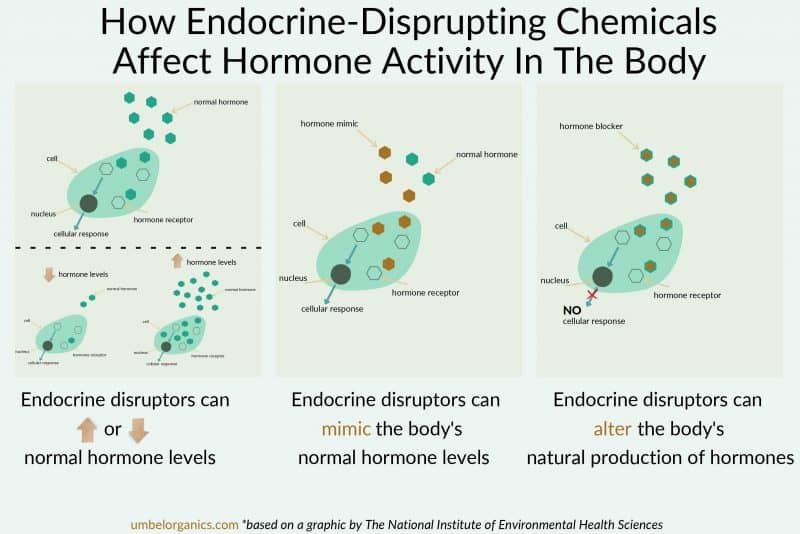
What do we know about endocrine disruptors during pregnancy? This is a critical question with significant implications for maternal and fetal health. These substances, found in various everyday products and environments, can interfere with the delicate hormonal balance crucial for healthy development. Understanding how these disruptors impact pregnancy is essential to protecting both the mother and the child.
We’ll explore the science behind endocrine disruptors, examining their sources, pathways of exposure, and potential impacts on fetal development. From environmental factors to lifestyle choices, we’ll uncover how these chemicals can affect the pregnancy journey. We’ll also delve into research methods, highlighting both what we know and the knowledge gaps that remain.
Defining Endocrine Disruptors

Endocrine disruptors are substances that interfere with the body’s hormone system. These chemicals can mimic, block, or alter the actions of hormones, leading to a wide range of adverse health effects, particularly during sensitive developmental periods like pregnancy. Understanding these disruptors is crucial for protecting human health and the environment.Endocrine disruptors work by interfering with the delicate balance of hormones in the body.
They can bind to hormone receptors, preventing natural hormones from binding and exerting their effects. Alternatively, they might mimic natural hormones, leading to inappropriate hormonal responses. This disruption can affect various bodily functions, including growth, development, reproduction, and metabolism. The consequences can manifest in both immediate and long-term effects, potentially impacting multiple generations.
Types of Endocrine Disruptors
Endocrine disruptors encompass a diverse array of chemical substances. They can be found in various sources, including industrial chemicals, pesticides, and certain plastics. Identifying and understanding the specific mechanisms of these disruptors is crucial for implementing effective preventative measures.
Common Endocrine Disruptors and Their Potential Effects
Numerous chemicals are suspected or known to act as endocrine disruptors. Their presence in the environment and our bodies raises significant concerns. Below is a table summarizing some common examples.
| Chemical Name | Source | Potential Effects | Known Routes of Exposure |
|---|---|---|---|
| Bisphenol A (BPA) | Plastics (e.g., polycarbonate bottles, food containers), receipts | Reproductive problems, developmental issues, potential impact on thyroid function | Ingestion, skin contact, inhalation |
| Phthalates | Plastics (e.g., toys, food packaging), personal care products | Reproductive issues, developmental problems, potential impact on the immune system | Ingestion, skin contact, inhalation |
| Pesticides (e.g., DDT, Atrazine) | Agricultural applications | Reproductive problems, developmental issues, potential impact on thyroid function | Ingestion, skin contact, inhalation |
| Perfluorinated Chemicals (PFCs) | Industrial processes, consumer products (e.g., non-stick cookware) | Reproductive issues, developmental problems, potential immune system and thyroid impacts | Ingestion, skin contact, inhalation |
| Heavy Metals (e.g., lead, mercury) | Industrial emissions, contaminated water and food | Neurodevelopmental problems, reproductive issues, and potential effects on the immune system | Ingestion, inhalation |
Mechanisms of Endocrine Disruption
Endocrine disruptors interfere with hormone systems through various mechanisms. They can bind to hormone receptors, mimicking or blocking natural hormones. This interference disrupts the delicate balance required for normal physiological processes, with potential long-term health consequences. The complex interactions between these chemicals and the human body make it difficult to fully understand the totality of their effects.
Exposure During Pregnancy
Pregnancy is a crucial period of development, where the fetus is particularly vulnerable to environmental influences. Understanding how endocrine disruptors enter the maternal system and potentially impact the developing fetus is vital for mitigating risks. This section explores potential sources of exposure, pathways of entry, and the crucial role of placental transfer.
Potential Sources of Exposure
Exposure to endocrine disruptors during pregnancy can stem from a variety of sources, both environmental and lifestyle-related. Environmental factors include exposure to industrial chemicals, pesticides, and certain plastics. These substances can contaminate air, water, and soil, creating ubiquitous exposure risks. Lifestyle choices, such as the consumption of certain foods, cosmetics, and personal care products, can also contribute to exposure.
- Environmental Factors: Contaminated water sources, agricultural runoff, air pollution from industrial processes, and even the presence of certain chemicals in building materials can expose pregnant individuals to a cocktail of potential endocrine disruptors. For example, persistent organic pollutants (POPs) like PCBs and dioxins can accumulate in the environment and enter the food chain, potentially affecting pregnant women and their unborn children.
- Lifestyle Choices: Diet plays a significant role. Certain foods, especially those with high levels of pesticide residues, can contribute to exposure. Exposure can also occur through cosmetics, personal care products, and even certain plastics used in food packaging. For instance, bisphenol A (BPA) is a chemical found in some plastics and can leach into food and beverages.
Pathways of Entry
Endocrine disruptors can enter the mother’s body through various pathways. These include ingestion, inhalation, and skin absorption. The route of entry can significantly impact the concentration and distribution of the disruptor within the body. Understanding these pathways is crucial to understanding potential impacts.
We’re learning more about how endocrine disruptors can affect developing babies during pregnancy, but it’s still a complex area. It’s interesting to consider how seemingly unrelated factors like exercise can positively impact health. For instance, incorporating 12 weeks of stretching, as detailed in how 12 weeks of stretching can improve your heart health , might be beneficial for overall well-being, which could potentially have knock-on effects for a healthy pregnancy.
Ultimately, understanding these connections helps us better protect the health of expecting mothers and their unborn children.
- Ingestion: Consuming contaminated food or water is a common pathway. For example, fish from polluted waters may accumulate harmful chemicals, posing a risk if consumed during pregnancy. Food packaging materials, certain types of canned goods, and even bottled water can contain traces of chemicals.
- Inhalation: Breathing in contaminated air, particularly air containing industrial fumes or agricultural sprays, can lead to exposure. The lungs act as a primary entry point, potentially exposing the circulatory system to disruptors.
- Skin Contact: Exposure through skin absorption is also possible, particularly with certain cosmetics, personal care products, or even through contact with contaminated surfaces. Some chemicals can readily penetrate the skin and enter the bloodstream.
Placental Transfer
The placenta, a vital organ during pregnancy, acts as a barrier between the mother and the fetus. However, some endocrine disruptors can cross this barrier, potentially reaching the developing fetus. The extent of transfer varies depending on the specific disruptor and the gestational age.
Comparison of Exposure Routes
| Exposure Route | Potential Impacts |
|---|---|
| Ingestion | Can lead to direct exposure through the digestive system. Accumulation in the body can occur over time, leading to possible long-term effects. |
| Inhalation | Directly exposes the respiratory system and can lead to a systemic distribution of disruptors throughout the body, potentially impacting various organ systems. |
| Skin Contact | Can cause localized effects at the point of contact, but some disruptors can be absorbed into the bloodstream, potentially reaching the fetus. The extent of absorption and transfer is highly variable. |
Impact on Fetal Development

Endocrine disruptors, lurking in our environment, can wreak havoc on developing fetuses. Exposure during pregnancy can lead to a range of adverse effects, impacting various organ systems and potentially causing long-term health consequences. Understanding the mechanisms of these disruptions is crucial for implementing preventative measures and safeguarding future generations.
Potential Adverse Effects on Specific Organs and Systems
Endocrine disruptors can interfere with the delicate hormonal balance crucial for fetal development. This interference can manifest in several ways, affecting different organs and systems. For instance, disruption of thyroid hormone production can lead to intellectual deficits, while disruptions in the hypothalamic-pituitary-adrenal (HPA) axis can influence stress response mechanisms throughout life. Reproductive development, particularly in both male and female fetuses, is also vulnerable to these disruptions.
Potential Long-Term Health Consequences
The consequences of exposure during fetal development can extend far beyond infancy. Studies suggest a link between prenatal exposure to endocrine disruptors and increased risk of certain diseases later in life, such as diabetes, obesity, and certain cancers. The precise mechanisms linking prenatal exposure to long-term health issues are still under investigation, but the potential for lasting impacts is significant.
Potential Developmental Abnormalities
Exposure to endocrine disruptors during specific periods of fetal development can lead to the emergence of various abnormalities. These include structural defects in organs and systems, such as the heart, brain, and reproductive organs. Furthermore, subtle changes in cognitive function, behavior, and neurodevelopment have also been observed in some studies. The impact is often dose-dependent and varies based on the specific disruptor and the timing of exposure during pregnancy.
Stages of Fetal Development and Potential Impacts
Understanding the developmental stages is key to recognizing potential impacts. Exposure at different stages can result in distinct consequences.
| Stage of Fetal Development | Potential Impacts of Endocrine Disruptor Exposure |
|---|---|
| Early Embryonic Stage (Weeks 1-8) | This critical period is when major organ systems are forming. Exposure during this stage can result in structural defects, particularly in the heart, brain, and spinal cord. For example, some studies suggest a correlation between exposure to certain chemicals and increased rates of neural tube defects. |
| Fetal Stage (Weeks 9-40) | During this period, the organs continue to develop and mature. Exposure to endocrine disruptors can influence the function and development of the endocrine system, including the thyroid, pancreas, and reproductive organs. For example, some studies suggest a correlation between exposure to certain chemicals and decreased sperm production in male fetuses. |
| Late Fetal Stage | The final stage of development is focused on refining organ function and preparing for birth. Exposure at this time can affect the developing brain and nervous system, which may lead to long-term behavioral or cognitive impacts. For example, exposure to certain chemicals has been linked to developmental delays in some studies. |
Research Methods and Studies
Unraveling the intricate effects of endocrine disruptors on pregnant women and their developing fetuses requires meticulous research. This involves understanding the various methodologies employed, their inherent limitations, and the crucial role of specific studies in building our knowledge base. The challenge lies in establishing definitive causal links between exposure to these substances and adverse health outcomes, considering the complexity of human biology and the diverse factors influencing pregnancy.
Methodologies Used in Research
Various research approaches are employed to investigate the impact of endocrine disruptors during pregnancy. These methods often involve a combination of epidemiological studies, laboratory experiments, and animal models. Epidemiological studies track populations to identify correlations between environmental exposures and health outcomes. Laboratory experiments, often using cell cultures or animal models, provide controlled settings to investigate the mechanisms of action of these disruptors.
Animal models allow researchers to explore the effects on reproductive development, while also providing a degree of control over the exposure levels.
Challenges and Limitations of Research Methods
Research into endocrine disruptors faces several challenges. Establishing direct cause-and-effect relationships between exposure and adverse outcomes can be difficult. Confounding factors, such as diet, lifestyle, and genetic predisposition, can influence the results, making it hard to isolate the impact of endocrine disruptors. Another key limitation is the difficulty in accurately measuring low-level exposures to these substances, particularly in the environment.
Also, extrapolating findings from animal models to humans may not always be accurate, as the biological processes in animals might differ significantly from those in humans. Furthermore, long-term follow-up studies are essential, but they require substantial resources and time commitment.
Examples of Specific Research Studies
Numerous studies have investigated the potential impact of endocrine disruptors on pregnancy. For example, research examining the link between phthalate exposure and preterm birth has revealed potential associations. Other studies have explored the relationship between bisphenol A exposure and various developmental outcomes in children. Research has also looked into the effects of pesticide exposure on fetal growth and development.
Comparative Analysis of Research Methodologies, What do we know about endocrine disruptors during pregnancy
| Methodology | Description | Strengths | Limitations | Example Studies |
|---|---|---|---|---|
| Epidemiological Studies | Observational studies that track populations to identify correlations between environmental exposures and health outcomes. | Can identify potential associations in large populations, can investigate real-world exposures. | Cannot establish cause-and-effect, prone to confounding factors. | Studies on the association between phthalate exposure and preterm birth. |
| Laboratory Experiments | Controlled experiments using cell cultures or animal models to investigate mechanisms of action. | Can isolate variables, examine specific mechanisms. | May not accurately reflect the complexity of human biology, extrapolating to humans may be difficult. | Studies investigating the effects of bisphenol A on cell growth. |
| Animal Models | Studies using animals to explore the effects of endocrine disruptors on reproductive development and other health outcomes. | Provides controlled exposures, useful for exploring mechanisms. | Extrapolating findings to humans may not always be accurate, ethical concerns related to animal use. | Studies investigating the impact of pesticide exposure on fetal growth. |
Current Understanding and Knowledge Gaps
Our current understanding of endocrine disruptors during pregnancy is a mix of alarming discoveries and frustrating gaps in knowledge. While we’ve identified numerous potential harms, pinpointing precise mechanisms and long-term consequences remains a challenge. This uncertainty underscores the critical need for more comprehensive research to fully appreciate the impact of these substances on developing fetuses and future generations.
Summary of Current Scientific Understanding
Current scientific research strongly suggests that exposure to endocrine-disrupting chemicals (EDCs) during pregnancy can have adverse effects on fetal development. These effects can range from subtle alterations in hormone levels to more significant developmental abnormalities. The evidence implicates a wide array of EDCs, including certain pesticides, industrial chemicals, and even some substances naturally occurring in the environment. A common thread is their ability to mimic or block the action of hormones, thus disrupting normal physiological processes during critical periods of fetal development.
This disruption can lead to a cascade of problems, affecting everything from reproductive health to neurological function.
We know that endocrine disruptors during pregnancy can have a significant impact on fetal development. Choosing a healthier lifestyle, like switching to a plant-based diet, can have a profound effect on overall well-being, and potentially even add years to your life, as detailed in this excellent article on how switching to a plant based diet can add years to your life no matter what age you are.
Avoiding exposure to these harmful substances through diet is crucial for a healthy pregnancy, and this often goes hand in hand with a plant-based approach. Ultimately, understanding these connections is key to promoting healthier pregnancies.
Areas Requiring Further Research
Several areas need more extensive investigation to fully understand the impact of EDCs during pregnancy. These include:
- Long-term effects: While some short-term effects are apparent, the long-term consequences of EDC exposure during pregnancy remain largely unknown. Studies need to track exposed individuals into adulthood to fully assess potential impacts on reproductive function, neurological development, and overall health. For instance, the impact of exposure on the development of diseases like type 2 diabetes or cardiovascular issues in later life requires further research.
Observational studies that follow cohorts of pregnant women exposed to specific EDCs throughout their pregnancies and into their children’s lives are crucial.
- Specific vulnerable populations: Not all individuals are equally susceptible to the effects of EDCs. Research needs to investigate how factors like genetic predisposition, socioeconomic status, and pre-existing health conditions may influence the impact of EDC exposure during pregnancy. For example, studies investigating the differential effects of exposure in low-income populations compared to higher-income populations are essential. Further, research should explore the specific vulnerabilities of pregnant women with underlying health conditions.
We know that endocrine disruptors during pregnancy can have serious impacts on fetal development, but the full scope of their effects is still being researched. Recent events like the NYC Legionnaires’ disease cluster, a concerning outbreak , highlight the need for better understanding of environmental toxins. Further research into the complex interplay between environmental exposures and pregnancy outcomes is critical for protecting future generations.
- Combined exposure to multiple EDCs: Humans are often exposed to a cocktail of EDCs, rather than a single substance. Understanding how these exposures interact and combine to influence fetal development is crucial. The effects of a combination of pesticides and industrial chemicals, for instance, could be different from the effects of individual components. Multi-exposure studies are essential to understand the combined impact of multiple EDCs.
- Mechanism of action: While we know EDCs interfere with hormone systems, a more detailed understanding of the precise molecular mechanisms underlying these disruptions is needed. Studies focusing on specific pathways and receptors affected by EDCs can provide a deeper insight into how these substances influence fetal development. This will lead to the development of more targeted interventions and prevention strategies.
Limitations of Existing Research
Existing research on EDC exposure during pregnancy has limitations that must be considered when interpreting findings.
- Limited sample sizes: Many studies on EDC exposure in pregnancy have relatively small sample sizes, making it difficult to generalize findings to broader populations. This limitation can lead to difficulties in establishing strong statistical correlations and drawing reliable conclusions about specific effects.
- Confounding factors: It’s often challenging to isolate the effects of EDCs from other factors that might influence fetal development, such as maternal health, diet, and lifestyle. Studies need to incorporate sophisticated statistical modeling to account for these confounding variables and ensure the results are truly attributable to EDC exposure.
- Variability in exposure levels: Exposure levels to EDCs can vary significantly depending on factors like location, diet, and lifestyle. Standardization of exposure assessment methodologies is crucial for accurate comparison across different studies.
- Ethical considerations: Research on human populations requires careful consideration of ethical implications, particularly when investigating potential risks to pregnant women and fetuses. Ethical review boards must carefully assess the potential benefits and risks associated with each study, and the rights of participants must be paramount.
Knowledge Gaps and Potential Research Directions
| Knowledge Gap | Potential Research Directions |
|---|---|
| Long-term effects of EDC exposure | Longitudinal studies following exposed individuals into adulthood, focusing on reproductive health, neurological development, and disease risk. |
| Differential susceptibility to EDCs | Studies examining the impact of genetic predisposition, socioeconomic status, and pre-existing health conditions on EDC effects. |
| Combined exposure to multiple EDCs | Multi-exposure studies evaluating the combined effects of various EDCs on fetal development. |
| Mechanism of action of EDCs | Research focusing on specific molecular mechanisms of EDC action, including affected pathways and receptors. |
Mitigation Strategies and Prevention: What Do We Know About Endocrine Disruptors During Pregnancy
Protecting a developing fetus from endocrine disruptors requires a multifaceted approach. Addressing exposure during pregnancy is crucial, as the developing endocrine system is highly susceptible to these harmful chemicals. Strategies range from individual lifestyle choices to broader societal changes, all aimed at minimizing exposure and promoting a healthier environment for expectant mothers and their babies.Effective mitigation strategies involve understanding the sources of exposure and implementing preventative measures.
This includes recognizing that endocrine disruptors aren’t confined to a single category of products, but rather are present in diverse everyday items. Proactive measures, both personal and societal, are key to safeguarding fetal development.
Potential Strategies for Reducing Exposure
Reducing exposure to endocrine disruptors necessitates a comprehensive approach, focusing on both individual lifestyle modifications and broader environmental changes. This involves conscious choices in daily routines and advocating for policies that limit the presence of these chemicals in the environment. Addressing exposure at multiple levels is vital to creating a safer environment for pregnant individuals.
Lifestyle Modifications
Implementing specific lifestyle changes can significantly decrease exposure to endocrine disruptors. These modifications include choosing healthier food options, minimizing exposure to certain household products, and optimizing personal care routines.
- Dietary Choices: Selecting organic foods whenever possible can reduce exposure to pesticides and other chemicals. Eating a balanced diet rich in fruits, vegetables, and whole grains provides essential nutrients and can help mitigate the impact of potential exposures. Avoiding processed foods, particularly those containing preservatives and artificial additives, is also beneficial.
- Household Product Selection: Opting for products with minimal or no endocrine-disrupting chemicals, such as BPA-free plastics and non-toxic cleaning supplies, is crucial. Reading labels carefully and seeking out brands committed to sustainability and safer ingredients are important steps.
- Personal Care Products: Choosing personal care products with natural ingredients and avoiding those containing phthalates, parabens, or other known endocrine disruptors can help limit exposure. Understanding the potential presence of these chemicals in cosmetics, lotions, and shampoos is key.
Environmental Precautions
Taking precautions to minimize exposure to endocrine disruptors in the environment is equally important. This includes avoiding exposure to certain industrial chemicals and promoting environmental stewardship.
- Water Quality: Ensuring access to clean drinking water is crucial. Using filters and understanding local water quality reports can help reduce exposure to contaminants. Awareness of potential contamination sources in water is critical.
- Air Quality: Minimizing exposure to air pollution, particularly in areas with high industrial activity, is essential. Choosing to live in or visit less polluted environments when possible can help reduce exposure.
- Environmental Stewardship: Supporting organizations and policies that promote sustainable practices and reduce industrial pollution can have a broader impact on reducing exposure to endocrine disruptors.
Specific Examples of Interventions
Numerous interventions are being implemented to reduce the risk of exposure to endocrine disruptors. These include governmental regulations, industry standards, and consumer awareness campaigns.
- Phthalate restrictions: Many countries have implemented regulations limiting the use of phthalates in certain products, recognizing their endocrine-disrupting properties.
- BPA-free products: The increasing availability of BPA-free alternatives for food and beverage containers is a positive step towards minimizing exposure.
- Public awareness campaigns: Educational campaigns are raising public awareness about the risks associated with endocrine disruptors, empowering individuals to make informed choices.
Practical Strategies for Reducing Exposure
| Category | Strategies |
|---|---|
| Dietary Choices | Choose organic foods, eat a balanced diet, avoid processed foods with artificial additives. |
| Household Products | Select products with minimal or no endocrine disruptors, read labels carefully. |
| Personal Care Products | Choose products with natural ingredients, avoid those with phthalates, parabens. |
| Environmental Precautions | Use water filters, understand local water quality, minimize exposure to air pollution. |
| Support for Interventions | Advocate for policies that promote sustainable practices, support organizations working to reduce industrial pollution. |
Conclusive Thoughts
In conclusion, understanding endocrine disruptors during pregnancy is vital for informed choices and proactive measures. While research continues to illuminate the complexities of these substances, it’s clear that reducing exposure is crucial for promoting healthy pregnancies. By understanding the potential risks and adopting preventive strategies, we can work towards a healthier future for both mothers and their children.





